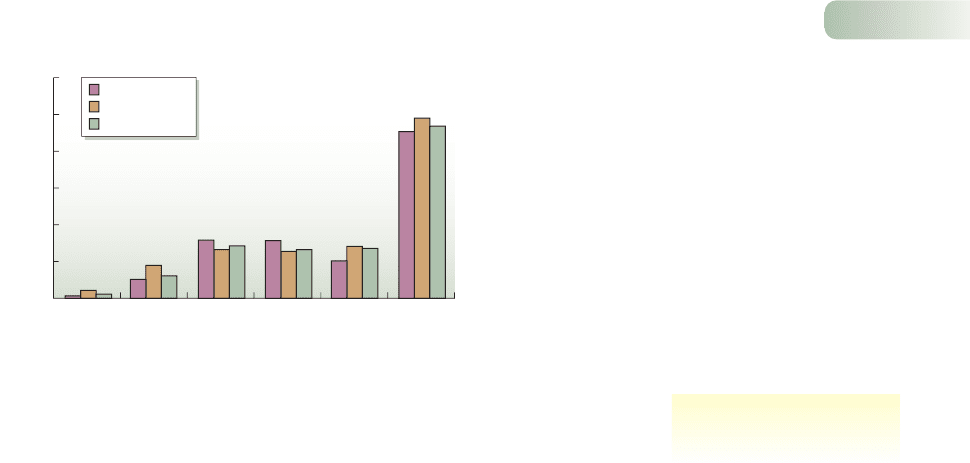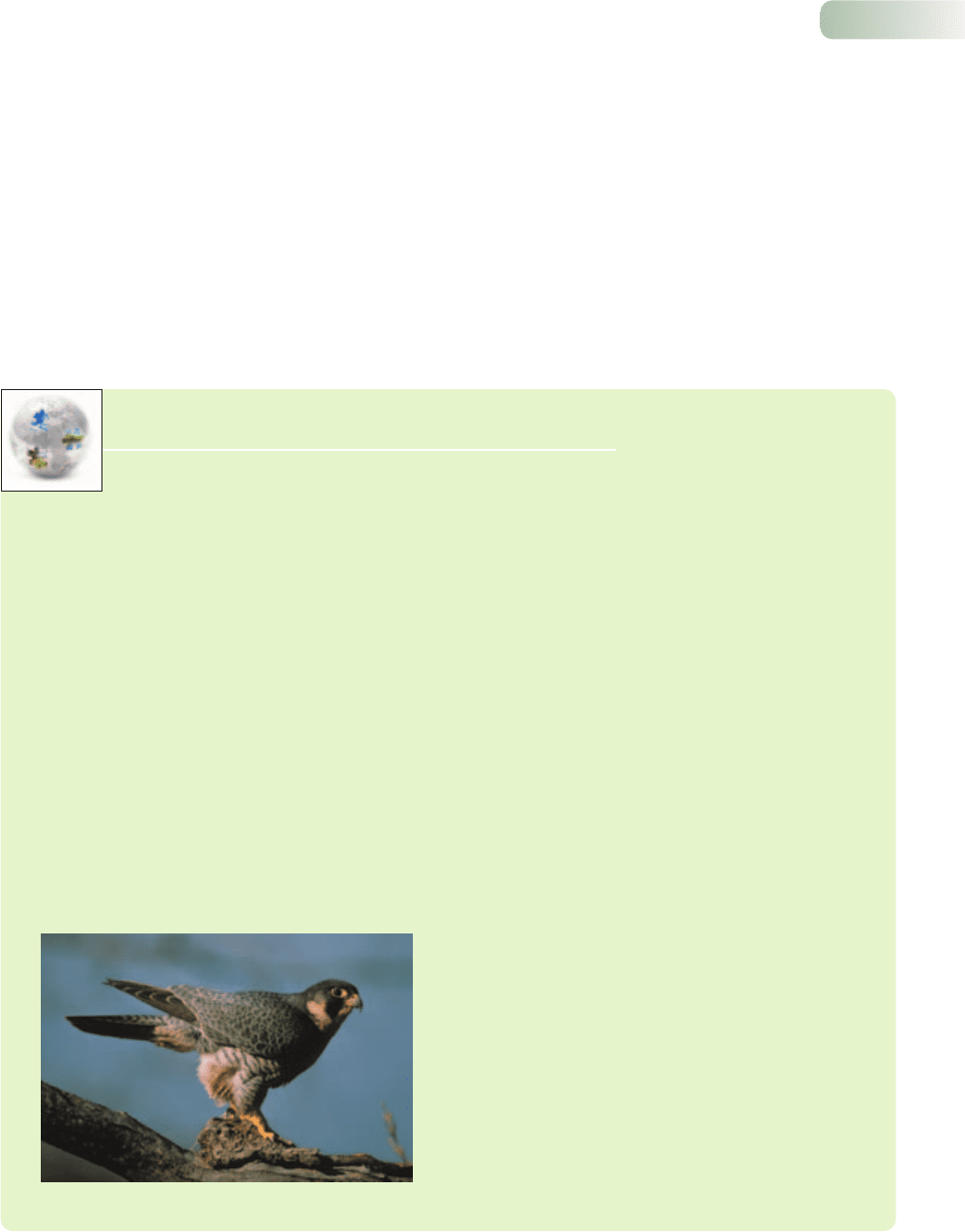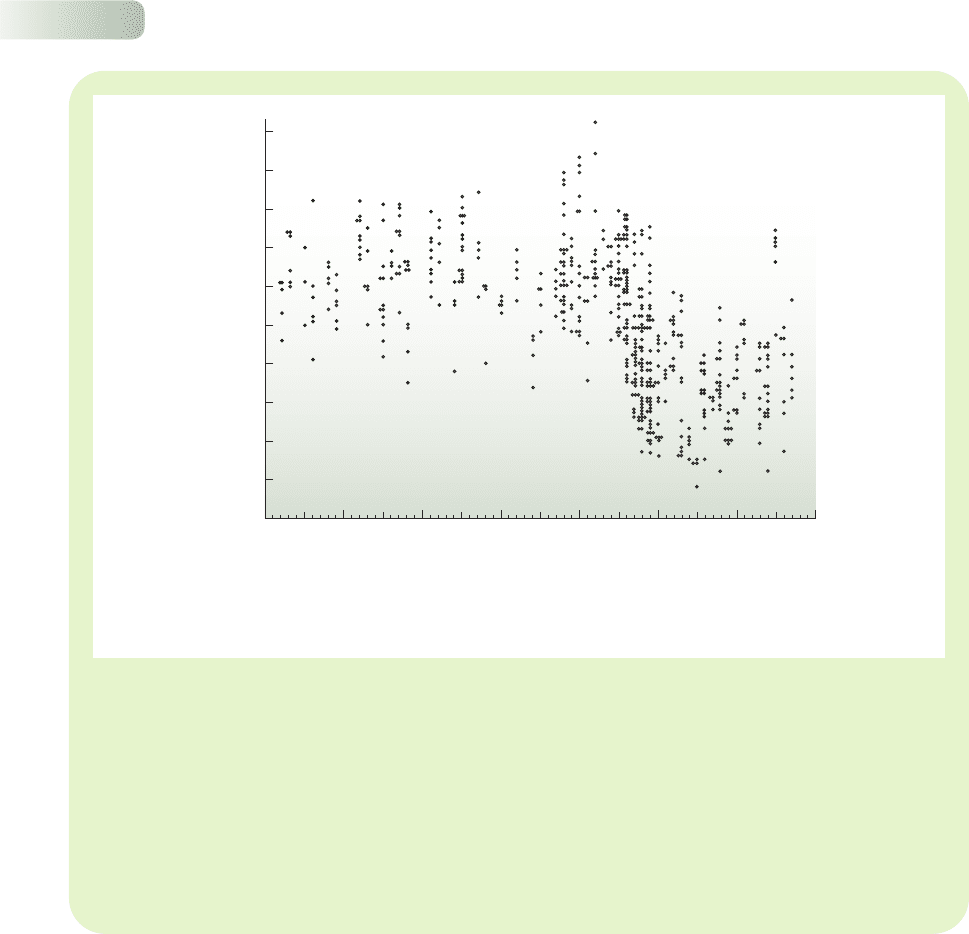Townsend C.R., Begon M., Harper J.L. Essentials of Ecology
Подождите немного. Документ загружается.


These approaches have advantages in terms of reduced environmental hazard.
Even so, it is unreasonable to suppose that they will be adopted widely unless
they are also sound in economic terms. As we have already noted, in an industry
such as agriculture, practices that are economically unsustainable are, ultimately,
unsustainable overall. In this context, Figure 12.19 shows the yields of apples
from organic, conventional and integrated production systems in Washington
State from 1994 to 1999 (Reganold et al., 2001). Organic management excludes
such conventional inputs as synthetic pesticides and fertilizers whilst integrated
farming uses reduced amounts of chemicals by integrating organic and conven-
tional approaches. All three systems gave similar apple yields but the organic
and integrated systems had higher soil quality and potentially lower environ-
mental impacts. When compared with conventional and integrated systems, the
organic system produced sweeter apples, higher profitability and greater energy
efficiency.
12.7 Forecasting agriculturally driven
global environmental change
Much attention has been focused on the predicted far-reaching consequences
of global climate change caused by human activities such as the burning of fossil
fuels. We deal with this in Chapter 13. However, very significant threats are also
posed to ecosystems around the world by increasing agricultural development.
In this chapter we have considered the problems of the more-than-exponential
increase in the human population, and of the associated impacts of increased
erosion, unsustainability of water supply, salinization and desertification, excess
plant nutrients finding their way into waterways, and unwanted consequences of
chemical pesticides. Model projections suggest that all these will increase over
the next 50 years as more land is converted to grow crops and pasture (Tilman
et al., 2001) (Figure 12.20). This can be expected to place biodiversity at high
risk, particularly because population increases are predicted to be greatest in
species-rich tropical areas. To control the environmental impacts of agricultural
expansion, we will need scientific and technological advances as well as the
implementation of effective government policies.
Chapter 12 Sustainability
419
environmental and economic
sustainability
Year
Cumulative
(1995–9)
300
250
200
150
100
50
0
Yield (tons ha
–1
)
1995 1996 1997 1998 1999
Organic
Conventional
Integrated
Figure 12.19
Fruit yields (metric tons per hectare) of three apple production
systems.
FROM REGANOLD ET AL., 2001
9781405156585_4_012.qxd 11/5/07 15:01 Page 419

Part IV Applied Issues in Ecology
420
Pasture
N fertilizers
P fertilizers
Irrigation
Pesticides
Cropland
150
100
50
0
Agricultural variable
Projected increase (%)
Figure 12.20
Projected increases in nitrogen (N) and phosphorus (P) fertilizers,
irrigated land, pesticide use and total areas under crops and pasture
by the years 2020 (maroon bars) and 2050 (green bars).
FROM LAURANCE 2001, BASED ON DATA IN TILMAN ET AL., 2001
The human population ‘problem’
Resource use by humans is defined as sustainable if
it can be continued for the forseeable future. The root
of most environmental problems is the ‘population
problem’: a large human population that has been
growing at a more-than-exponential rate.
Three groups of nations can be recognized: those
that passed through the demographic transition ‘early’,
‘late’ or ‘not yet’. Even if it were possible instantane-
ously to bring about the transition in all remaining
countries of the world, the population problem would
not be solved, partly because population growth has
its own momentum.
The global carrying capacity for humans is variously
estimated at between 1 and 1000 billion, depending
mainly on what is deemed to constitute an acceptable
standard of living.
Harvesting living resources from the wild
Whenever a natural population is exploited by harvest-
ing there is a risk of overexploitation. But harvesters
also want to avoid underexploitation – when potential
consumers are deprived of resources and those who
do the harvesting are underemployed.
The concept of the maximum sustainable yield
(MSY) has been a guiding principle in the exploita-
tion of natural populations. There are two simple
ways of obtaining an MSY on a regular basis:
through a ‘fixed quota’ and through a ‘fixed effort’.
Two limitations of the MSY approach are: (i) that it
treats all individuals in the population as identical;
and (ii) that it treats the environment as unvarying.
Improved harvesting strategies correct both these
oversights. Lack of knowledge of most fisheries
around the world means that management is often
based on the precautionary principle, often in the
absence of data.
The farming of monocultures
Increasingly, animals and plants have been domestic-
ated and managed in ways that allowed much larger
harvests – usually as monocultures. But a high price
may be paid to maintain these high rates of food pro-
duction. Monocultures offer ideal conditions for the
SUMMARY
Summary
9781405156585_4_012.qxd 11/5/07 15:02 Page 420

Chapter 12 Sustainability
421
epidemic spread of diseases and lead to widespread
degradation of land.
The sustainability of soil and of water supplies
In an ideal sustainable world, new soil would be formed
as fast as the old was lost, but in most agricultural
systems this is not achieved. When there is an over-
whelming reliance on artificial fertilizers, maintaining the
organic matter capital of the soil tends to be neglected
and this has declined worldwide.
Soil degradation can be slowed down by incorpor-
ating manures and residues, alternating cultivation and
fallow periods, or returning the land to grazed pasture.
In tropical regions, terracing is widely practiced over hilly
and mountainous terrain. In arid regions, overgrazing
and excessive cultivation can lead to desertization
and salinization.
Water is widely thought to be the resource that
future wars will be fought over. On a global scale,
agriculture is the largest consumer of fresh water.
Pumping water from underground aquifers is the
main cause of loss of agricultural land through
salinization.
Pest control
The aim of pest control is to reduce the pest popula-
tion to its economic injury level (EIL), but a so-called
economic threshold may be of more immediate
importance.
Pesticides may kill species other than their target
and may give rise to target pest resurgence or
secondary pest outbreaks. Pests may also evolve
pesticide resistance.
Biologists may also manipulate the natural
enemies of pests (biological control) via three forms
of biological control – importation, conservation or
inoculation – but even biocontrol agents can have
unwanted effects on non-target species.
Integrated farming systems
Integrated pest management (IPM) is a practical
philosophy of pest management that is ecologically
based but uses all methods of control where appro-
priate. It relies heavily on natural mortality factors and
calls for specialist pest managers or advisers.
Implicit in the philosophy of IPM is the idea that
pest control cannot be isolated from other aspects of
food production. A number of programs have been
initiated to develop and put into practice sustain-
able food production methods that incorporate IPM.
Evidence has been accumulating that this sustain-
able farming approach can yield improved economic
returns too.
Agriculturally induced global change
It is clear that very significant threats are posed to
ecosystems around the world by the increasing human
population and concomitant increases to agricultural
development. These are expected to have a par-
ticularly damaging effect on biodiversity because
most agricultural growth is predicted to occur in the
species-rich tropics.
REVIEW QUESTIONS
Review questions
Asterisks indicate challenge questions
1* What is sustainability? Is it possible to have
sustainable population growth? Sustainable use
of fossil fuels? Sustainable use of forest trees?
Justify your answers.
2 Describe what is meant by ‘the demographic
transition’ in a human population. Explain why
it might be important, for future management of
human population growth, to discover whether
the demographic transition is an academic
ideal or a process through which all human
populations necessarily pass.
s
9781405156585_4_012.qxd 11/5/07 15:02 Page 421

Part IV Applied Issues in Ecology
422
3* The number of people that the Earth can
support depends on their standard of living.
Argue the case either for or against developing
nations having the right to expect standards
of living those in the developed world take for
granted.
4 Contrast the ways in which ‘fixed quota’ and
‘fixed effort’ harvesting strategies seek to
extract maximum sustainable yields from
natural populations.
5 Discuss the pros and cons of agricultural
monocultures.
6 One of the main bodies regulating the
production of organic food (food produced
without synthetic fertilizers or pesticides) in the
United Kingdom is the Soil Association. Explain
why you think it has adopted this name.
7 Explain the meaning and importance of the terms
economic injury level and economic threshold.
8 Weigh up the advantages and disadvantages of
the chemical and biological control of pests.
9 Explain why methods of pest control and
methods of soil fertility maintenance need
to be considered together in integrated
farming systems.
10* Hilborn and Walters (1992) have suggested
that there are three attitudes that ecologists
can take when they enter the public arena.
The first is to claim that ecological interactions
are too complex, and our understanding and
our data too poor, for definite pronouncements
to be made (for fear of being wrong). The
second possibility is for ecologists to
concentrate exclusively on ecology and
arrive at a recommendation designed to
satisfy purely ecological criteria. The third
is for ecologists to make ecological
recommendations that are as accurate and
realistic as possible, but to accept that these
will be incorporated with a broader range
of factors when management decisions are
made – and may be rejected. Which of these
do you favor, and why?
s
9781405156585_4_012.qxd 11/5/07 15:02 Page 422

423
Chapter 13
Habitat degradation
CHAPTER CONTENTS
13.1 Introduction
13.2 Degradation via cultivation
13.3 Power generation and its diverse effects
13.4 Degradation in urban and industrial landscapes
13.5 Maintenance and restoration of ecosystem services
Chapter contents
KEY CONCEPTS
In this chapter you will:
l
realize that Homo sapiens is just one species among many whose
activities can reduce the quality of their environment – but to a
dramatically greater extent
l
understand that we have both physical effects (such as desertization
and changes to riverflow) and chemical impacts (pollution by nitrates,
carbon dioxide, chlorofluorocarbon, etc.)
l
recognize that most pollutants produced on land ultimately affect the
atmosphere or rivers, lakes and oceans
l
understand that power generation is responsible for the most far-
reaching environmental impacts when the carbon dioxide released
contributes to global climate change
l
appreciate the value to human welfare of ecosystem services lost when
we degrade habitats
Key concepts
9781405156585_4_013.qxd 11/5/07 15:03 Page 423

13.1 Introduction
13.1.1 Physical and chemical impacts of
human activities
People destroy or degrade natural ecosystems to make way for agricultural, urban
and industrial development. We physically damage the natural world when
mining for non-renewable resources such as gold and oil, and even exploitation
of a renewable resource can disrupt habitat when, for example, bottom trawling
for fish damages deep-sea coral communities. The worldwide scale of damage is
even greater as a result of chemical pollution produced by human activities such
as defecation, cultivation, power generation and industry.
Humans are not unique in degrading their environment. Feces, urine and
dead bodies of animals are sometimes sources of pollution in their immediate
environments – cattle avoid grass near their waste for several weeks, many birds
carry away the fecal sacs of their nestlings and the ‘undertaker’ caste of honeybees
removes dead bodies from the hive. Like us, many species also make profound
physical changes to their habitats. Among the ‘ecological engineers’ of the natural
world are beavers that construct dams, prairie dogs that build underground towns
and freshwater crayfish that clear sediment from the riverbed. In each case,
other species in the community are affected. And there are even species that, like
farmers, increase plant nutrient concentrations in their habitats (leguminous
plants – see Section 8.4.6), and others that produce ‘pesticides’ (certain plants
produce allelochemicals, the function of which appears to be the inhibition of
growth of neighbors).
When population density was low, and prior to our harnessing of non-food
energy, humans probably had no greater impact than many other species. But now
the scale of human effects is proportional to our huge numbers and the advanced
technologies we employ.
Physical degradation of habitats includes soil loss and desertization caused by
intensive agriculture (discussed in Section 12.4.1) and changes to river discharge
as a result of water impoundment for hydropower generation or abstraction for
irrigation of crops (Section 13.2.5).
Chemical degradation has many causes. Pesticides are applied to land but
find their way to places they were not intended to be – passing up food chains
Part IV Applied Issues in Ecology
424
Homo sapiens – just another
species?
As the human population has grown and new technologies have been developed,
we have had an ever-increasing impact on natural ecosystems. Physical
degradation and chemical pollution associated with cultivation, power generation,
urban life and industry have adversely affected human health and many
‘ecosystem services’ that were free and contributed greatly to human welfare.
Our environmental problems have ecological, economic and sociopolitical
dimensions, so a multidisciplinary approach will be needed to find solutions.
the scale of human degradation
reflects our population density
and technology
physical degradation of habitats
chemical degradation – pollution
9781405156585_4_013.qxd 11/5/07 15:03 Page 424

(Box 13.1) and moving via ocean currents to the ends of the Earth. A plethora of
other exotic chemicals enter the natural environment from a variety of industrial
sources. But the most far-reaching kinds of chemical degradation result not from
our production of exotic chemicals but rather the augmentation of simple com-
pounds that already occur naturally. The heavy use on land of nitrogen fertilizer
spills into rivers, lakes and oceans, where raised levels of nitrate severely disrupt
ecosystem processes – with blooms of microscopic algae shading out waterweeds
and, when the algae die and decompose, reducing oxygen and killing animals.
Another pollutant route is via the atmosphere. Thus, hundreds of kilometers
downwind of large population centers, acid rain (caused by emission of oxides
of nitrogen and sulfur from power generation) kills trees and drives lake fish
Chapter 13 Habitat degradation
425
13.1 TOPICAL ECONCERNS
13.1 Topical ECOncerns
The peregrine falcon (Falco peregrinus) is a particu-
larly distinctive and beautiful bird of prey with an almost
worldwide range. Until the 1940s, about 500 pairs bred
regularly in the eastern states of the United States and
about 1000 pairs in the west and in Mexico. In the late
1940s their numbers started a rapid decline, and by
the mid-1970s the bird had disappeared from almost
all the eastern states and its numbers had fallen by
80–90% in the west. Similar dramatic declines were
occurring in Europe. Peregrine falcons were listed
as an endangered species (at risk of extinction). The
decline also occurred in many other birds of prey and
was traced to failure to hatch normal broods. There
was very high breakage of eggs in the nest.
The cause was eventually identified as the accumu-
lation of DDT (dichlorodiphenyltrichloroethane) in the
parent birds. The pesticide had apparently contamin-
ated seeds and insects that had then been eaten by
small birds and had accumulated in their tissues. In
turn these had been caught and eaten by birds of prey
and the pesticide interfered with their reproduction –
in particular causing the eggs to have thin shells and
be more likely to break.
The use of DDT was banned in the United States in
1972. Programs were developed to breed peregrines
in captivity and at least 4000 peregrines were bred
and released to the wild. Peregrines are now breed-
ing successfully over much of the United States and
are no longer considered an endangered species.
In Britain, recovery has been so successful that the
peregrine has become regarded as a pest by pigeon
fanciers and lovers of the smaller songbirds.
It was possible to identify DDT pollution as a cause
of eggshell thinning because eggshells had been col-
lected as dated specimens in museums and private
collections. A measure of eggshell thickness in col-
lections of eggs of the sparrow hawk (Accipiter nisus)
showed a sudden stepwise fall of 17% in 1947, when
DDT began to be used widely in agriculture, and a
steady increase in thickness after DDT was banned
(Figure 13.1).
Pollution and the thickness of birds’ eggshells
s
© JEAN HOSKINS, FLPA 02176-00109-147
9781405156585_4_013.qxd 11/5/07 15:03 Page 425

extinct. And the biggest pollution problem of all involves the augmentation, via
the burning of fossil fuels, of carbon dioxide in the atmosphere. The consequent
global climate change has implications for every ecosystem in the world.
Our discussion of human degradation of habitats will first consider the
consequences of cultivation (Section 13.2), before proceeding to an assessment
of damage associated with the generation of power (Section 13.3), and then the
ecological consequences of life in urban and industrial landscapes (Section 13.4).
But first (Section 13.1.2) we will note how the cost of our activities can be
tallied in relation to the free ‘ecosystem services’ that are lost when habitats are
degraded. Discussion returns to this theme in the final section (13.5), which
strikes a more optimistic note by discussing actions that can be taken to maintain
or restore ecosystem services.
Part IV Applied Issues in Ecology
426
It was a surprise to ornithologists in Britain to find
evidence of a decline in eggshell thickness of 2–10%
in four species of thrush (Turdus) since the mid-19th
century (Green, 1998). This seemed to have started
long before the development of organic pesticides
and there was no sudden change when DDT was
introduced. Snails are an important part of the diet of
thrushes; thrushes derive much of the calcium for their
eggshells from snails. There is convincing evidence
that acid rain, caused by release to the atmosphere
of sulfur and nitrogen oxides from power generation
and industry, has acidified leaf litter and reduced
its calcium content, leading to a reduction in snail
populations and in the calcium content of their shells.
The shells of wild birds’ eggs have therefore recorded
two of the major, but quite different, forces of environ-
mental pollution: pesticides (Section 13.2.5) and acid
rain (Section 13.3.1).
s
1.80
1.70
1.60
1.50
1.40
1.30
1.20
1.10
1.0
0.9
0.8
1900 1910 1920 1930 1940 1950 1960 1970
Eggshell index
Year
Figure 13.1
Graph showing the changes in sparrowhawk eggshell thickness (museum specimens) in Britain.
FROM RATCLIFFE, 1970
9781405156585_4_013.qxd 11/5/07 15:03 Page 426

13.1.2 Economic costs of human impacts: lost
ecosystem services
Biodiversity has intrinsic value. But there is also a utilitarian view of nature that
focuses on the services that ecosystems provide for people to use and enjoy.
Provisioning services include wild foods such as fish from the ocean and berries
from the forest, medicinal herbs, fiber, fuel and drinking water, as well as the
products of cultivation in agroecosystems. Nature also contributes the cultural
services of esthetic fulfilment and educational and recreational opportunities.
Regulating services include the ecosystem’s ability to break down or filter out
pollutants, the moderation by forests and wetlands of disturbances such as floods,
and the ecosystem’s ability to regulate climate (via the capture or ‘sequestration’
by plants of the greenhouse gas carbon dioxide). Finally, and underlying all the
others, there are supporting services such as primary production, the nutrient
cycling upon which productivity is based, and soil formation.
In the case of three important provisioning services – production of crops,
livestock and aquaculture – human activities have had a positive effect. And because
of increased tree planting in some parts of the world there has even been a global
improvement in the sequestration of carbon by trees (a climate regulating service).
But we have degraded most of the other services (Millennium Ecosystem Assess-
ment 2005). As discussed in Chapter 12, many fisheries are now overexploited
(a negative effect on this provisioning service), while intensive agriculture has
worked against the ecosystem’s ability to replace soil lost to erosion (a regulating
service). The continuing loss of forest in tropical regions has negative effects on
the ability of the terrestrial ecosystem to regulate riverflow – deforestation
increases flow during flooding and decreases it during dry periods. And, as we saw
in Section 1.3.3, deforestation (or even just the loss of riverside vegetation) can
diminish the terrestrial ecosystem’s capacity to hold and recycle nutrients (another
regulating service), releasing large quantities of nitrate and other plant nutrients
Chapter 13 Habitat degradation
427
Acid rain damage to spruce forest.
© ROB AND ANN SIMPSON, VISUALS UNLIMITED
provisioning, cultural, regulating
and supporting services
a few positive human effects on
ecosystem services...
. . . but many negative effects
9781405156585_4_013.qxd 11/5/07 15:03 Page 427

into waterways. Note that the modification of an ecosystem to enhance one service
(e.g. intensification of agriculture to produce more crop per hectare – a provision-
ing service) generally comes at a cost to other services previously provided (loss
of regulating services such as nutrient uptake and of cultural services such as
sacred sites, streamside walks and valued biodiversity) (Townsend, 2007).
The concept of ecosystem services is important because it focuses on how eco-
systems contribute to human well-being, providing a counterpoint to the economic
reasons that justify our degradation of nature in the first place (to produce food,
fiber, fuel, housing and luxury products for a burgeoning human population).
Economists can put a value on nature in a variety of ways. A provisioning service
for which there is a market is straightforward – values are easily ascribed to clean
water for drinking or irrigation, to fish from the ocean and medicinal products from
the forest. A more imaginative approach is required in other situations. Thus, the
travel cost that tourists are willing to pay to visit a natural area provides a minimum
value of the cultural service provided. To determine contingent valuation, surveys
of the public assess their willingness to pay for each of a set of alternative land use
scenarios; the answer is thus ‘contingent’ on a specific hypothetical scenario and
description of the environmental service concerned. Replacement cost estimates
how much would need to be spent to replace an ecosystem service with a man-
made alternative, for example by substituting the natural waste disposal capacity
of a wetland by building a treatment works. And when an ecosystem service has
already been lost, the real costs become apparent. Take, for example, the largely
deliberate burning of 50,000 km
2
of Indonesian vegetation in 1997 – the economic
cost comprised US$4.5 billion in lost forest products and agriculture, increased
greenhouse gas emissions, reductions to tourism and healthcare expenditure on
12 million people affected by the smoke (Balmford & Bond 2005).
Costanza et al. (1997) added up all ecosystem services worldwide, arriving
at an estimate of US$38 trillion (10
12
) – more than the gross domestic product
of all nations combined. This ‘new economics’ provides persuasive reasons for
taking greater care of ecosystems and the biodiversity they contain.
13.2 Degradation via cultivation
When intensive livestock production forces animals to live the equivalent of urban
life, their waste is produced faster than natural decomposers and detritivores can
handle it (see Chapter 11). All the problems of human urban overpopulation
then apply to domestic livestock. Intensive agriculture is also associated with an
increase in the level of the nitrate and phosphate that runs into rivers and lakes
(and into drinking water) and problems associated with the use of insecticides and
herbicides. As we have already seen in Section 12.7, the environmental threats posed
by agricultural intensification are expected to increase in the coming decades.
13.2.1 Intensive livestock management
Pigs, cattle and poultry are the three major contributors to pollution in industrial-
ized agriculture feedlots. The waste from factory-farmed poultry is easily dried
and forms a transportable, inoffensive and valuable crop and garden fertilizer. In
contrast, the excreta from cattle and pigs are 90% water and have an unpleasant
Part IV Applied Issues in Ecology
428
a valuation of ecosystem
services...
. . . adding up to a global total of
$38 trillion
excreta from cattle and pigs is
bulky (and smelly) but poultry
waste is more acceptable
9781405156585_4_013.qxd 11/5/07 15:03 Page 428
